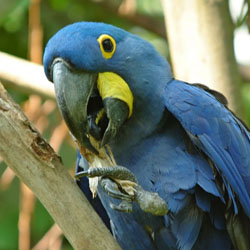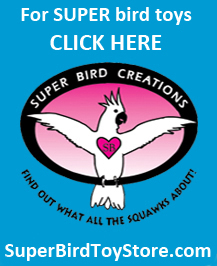 Grooming Your Bird's Nails
Grooming Your Bird's Nails
It is easy to know when your parrot’s nails need attention. The first sign we often recognize is usually the presence of scratches and punctures on your own hand or shoulder (ouch!) or we might observe our bird nibbling on his nails. Another way to periodically check is to simply place your parrot companion on a flat surface. If a nail is so long that it lifts the ball at the end of the toe off the surface then your bird is in need of a manicure. Overgrown nails can prevent proper toe alignment and, in turn, make it difficult to grip food and perches properly. In extreme cases, seriously overgrown nails can cause lameness.
There are many handy grooming tools to assist you in maintaining trimmed nails for your parrot companion. Some people prefer to use nail clippers and others prefer to use dremmel or cautery tools. Dremmel tools grind the nail down using an abrasive wheel. Cautery products separate the nail by burning through it. The benefit of using either a dremmel or cautery tool is that if you trim the nail too short and nick the vein, the friction of the dremmel and the heat of the cautery tool will cauterize the vein and stop the bleeding. Another benefit of using a dremmel is that it often leaves a smooth rounded nail surface instead of a rough edge.
No matter what tool you decide to use, be sure to know what you are doing before you start. Always seek professional veterinary help, if you do not feel comfortable in manicuring your parrot companion yourself. At a minimum, it is highly recommended that you get a lesson in nail grooming from your avian vet so you know the proper techniques for restraining your bird, how to use the tools and how short and at what angle to cut your bird's nails.
If you decide to proceed with grooming be sure to:
- Be prepared. Assemble all the supplies you will need including the appropriate tools, towel, and first aid kit containing a clotting agent.
- Have a friend on hand to gently restrain your bird while you handle the trimming.
- Be aware that there is a blood vein inside each nail. Carefully examine the nail for veins which are easy to spot in birds with light colored nails and nearly impossible to spot in birds with dark nails.
- If you can't spot the vein, remove the sharp tips only. It's better to remove a little bit at a time rather than too much.
- Cutting too short can be painful to a bird and will increase the risk of bleeding.
- If bleeding occurs apply a clotting agent to the nail with pressure until the bleeding ceases.
- Be careful not to twist your parrots feet and legs as this may cause injury.
- Check your bird's nails after a few minutes to make sure bleeding doesn't occur or reoccur.
Clipping your parrot companion’s nails may leave irregular edges that you might want to buff out.



















































































































































Comments powered by CComment